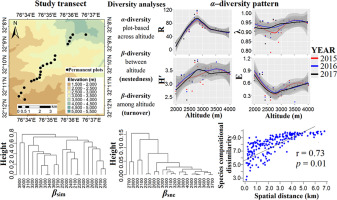当前位置:
X-MOL 学术
›
Sci. Total Environ.
›
论文详情
Our official English website, www.x-mol.net, welcomes your feedback! (Note: you will need to create a separate account there.)
Patterns of plant communities along vertical gradient in Dhauladhar Mountains in Lesser Himalayas in North-Western India.
Science of the Total Environment ( IF 9.8 ) Pub Date : 2020-01-24 , DOI: 10.1016/j.scitotenv.2020.136919 Mustaqeem Ahmad 1 , Sanjay K Uniyal 2 , Daizy R Batish 3 , Harminder P Singh 4 , Vikrant Jaryan 5 , Sonia Rathee 3 , Padma Sharma 4 , Ravinder Kumar Kohli 6
Science of the Total Environment ( IF 9.8 ) Pub Date : 2020-01-24 , DOI: 10.1016/j.scitotenv.2020.136919 Mustaqeem Ahmad 1 , Sanjay K Uniyal 2 , Daizy R Batish 3 , Harminder P Singh 4 , Vikrant Jaryan 5 , Sonia Rathee 3 , Padma Sharma 4 , Ravinder Kumar Kohli 6
Affiliation

|
Mountains are definitely the most rugged, yet frail resources and biodiversity-rich regions of the world. Environmental variables directly affect species composition, growth patterns, and the ecosystem resulting in a drastic change in the vegetation composition along ascending elevations. The present study investigated vegetation composition, nestedness, and turnover in plant communities along a vertical gradient (2000 to 4000 m) in Dhauladhar Mountains, Lesser Himalayas, India. We determined how α-diversity pattern and nestedness-related processes or turnover (β-diversity) causes dissimilarity in plant communities' composition along the vertical gradient. Overall, 21 permanent plots (20 × 20 m2) at every 100 m interval from 2000 to 4000 m were established. A sampling of shrubs and herbaceous species was done by marking sub-plots of 5 × 5 m2 and 1 × 1 m2, respectively, within permanent plots. We observed an inverted hump-shaped pattern for evenness index (E), a unimodal hump-shaped pattern for Shannon index (H'), Margalef's richness index, and β-Whittaker (βw) diversity, and mild-hump-shaped pattern for Simpson index (λ) across the elevational gradient. Turnover (βsim) and the nestedness-resultant component of β-diversity (βsne) significantly differed across the elevational gradient. The observed β-diversity patterns revealed that the species replacement rate was less in the mid-altitude communities as compared to lower and higher altitude communities. It was largely attributed to the ecotonic nature of mid-altitudes, which benefited mid-elevational communities rather than low or high altitude communities. Besides lower altitudes, the increased human interference has led to disturbance and subsequent homogenization of flora across the mid-altitudes. With respect to this, the present study signifies the need for preserving the mid-altitudinal communities, without undermining the importance of conserving the low and high altitude communities.
中文翻译:

植物群落的模式沿垂直梯度在小喜马拉雅山的道拉德哈山脉中,在西北印度。
山脉无疑是世界上最崎,但最脆弱的资源和生物多样性丰富的地区。环境变量直接影响物种组成,生长方式和生态系统,导致植被组成沿上升高度急剧变化。本研究调查了印度小喜马拉雅山道拉德哈尔山脉沿垂直梯度(2000至4000 m)植物群落的植被组成,嵌套性和周转率。我们确定了α-多样性模式和与巢度相关的过程或周转率(β-多样性)如何导致植物群落组成沿垂直梯度的差异。总体而言,从2000年到4000 m,每隔100 m建立了21个永久性地块(20×20 m2)。通过在永久样地内分别标出5×5 m2和1×1 m2的子样,对灌木和草本物种进行采样。我们观察到了均匀度指数(E)的倒峰形图案,香农指数(H'),玛格丽夫的丰富度指数和β-惠特克(βw)多样性的单峰驼峰形图案以及温和驼峰形图案跨越海拔梯度的辛普森指数(λ)。在海拔梯度上,周转率(βsim)和β多样性的嵌套结果分量(βsne)显着不同。观察到的β-多样性模式表明,与海拔较高和较低的社区相比,中海拔社区的物种替代率较低。这主要归因于中海拔地区的经济性质,这使中高海拔社区受益,而不是低海拔或高海拔社区。除了海拔较低以外,人为干扰的增加还导致中海拔地区植物群受到干扰并随后变得均质化。对此,本研究表明需要保护中海拔社区,而又不损害保护低海拔和高海拔社区的重要性。
更新日期:2020-01-24
中文翻译:

植物群落的模式沿垂直梯度在小喜马拉雅山的道拉德哈山脉中,在西北印度。
山脉无疑是世界上最崎,但最脆弱的资源和生物多样性丰富的地区。环境变量直接影响物种组成,生长方式和生态系统,导致植被组成沿上升高度急剧变化。本研究调查了印度小喜马拉雅山道拉德哈尔山脉沿垂直梯度(2000至4000 m)植物群落的植被组成,嵌套性和周转率。我们确定了α-多样性模式和与巢度相关的过程或周转率(β-多样性)如何导致植物群落组成沿垂直梯度的差异。总体而言,从2000年到4000 m,每隔100 m建立了21个永久性地块(20×20 m2)。通过在永久样地内分别标出5×5 m2和1×1 m2的子样,对灌木和草本物种进行采样。我们观察到了均匀度指数(E)的倒峰形图案,香农指数(H'),玛格丽夫的丰富度指数和β-惠特克(βw)多样性的单峰驼峰形图案以及温和驼峰形图案跨越海拔梯度的辛普森指数(λ)。在海拔梯度上,周转率(βsim)和β多样性的嵌套结果分量(βsne)显着不同。观察到的β-多样性模式表明,与海拔较高和较低的社区相比,中海拔社区的物种替代率较低。这主要归因于中海拔地区的经济性质,这使中高海拔社区受益,而不是低海拔或高海拔社区。除了海拔较低以外,人为干扰的增加还导致中海拔地区植物群受到干扰并随后变得均质化。对此,本研究表明需要保护中海拔社区,而又不损害保护低海拔和高海拔社区的重要性。



























 京公网安备 11010802027423号
京公网安备 11010802027423号